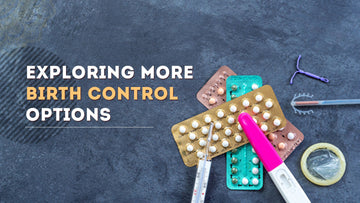
In one of our previous blogs, we discussed ARE CONDOMS 100% SAFE & EFFECTIVE? & BIRTH CONTROL OPTIONS OTHER THAN CONDOMS, where we learned how condoms are effective in preventing pregnancies and other transmitted diseases, as well as alternatives to condoms that can be considered with their effects and side effects. Today, we'll look into additional birth control options.
Let's look at some more birth control options here.
HORMONAL DEVICES
What Exactly It Is?
Your provider will insert a small rod the size of a matchstick under the skin of your upper arm. It provides a consistent supply of the hormone progestin and lasts about three years before needing to be removed or replaced. Some people prefer implants because they require little to no maintenance, do not interfere with the spontaneity of having sex, and can be kept hidden.
How Do Doctors Insert A Contraceptive Implant?
In their office, a healthcare provider inserts the implant. To begin, they numb the inside of your upper arm so you don't feel any pain. The implant is then placed just beneath your skin using an applicator. They apply a bandage to the affected area. You cannot remove your birth control implant without the assistance of a healthcare provider.
How can I obtain it?
A birth control implant must be prescribed by a healthcare provider
How Efficient Is It?
Birth control implants are nearly 100 percent effective. It is the most effective reversible contraception method available.
What Else Should You Be Aware Of?
Contraceptive implants carry risks and may not be appropriate for you. The most common side effect of an implant is irregular bleeding, which is usually light. This usually improves after six to twelve months, but some people never have their periods again. Sore breasts and headaches are among the other side effects.
What Exactly It Is?
A small, flexible, T-shaped device that is inserted into the uterus to prevent pregnancy is known as an Intrauterine Device (IUD). IUDs are divided into two categories:
An intrauterine device made of copper. A plastic IUD containing hormones (progestin).
The copper can be left in place for nearly ten years, depending on the brand and type. Copper prevents sperm from passing through your vaginal and uterine walls and reaching an egg.
Skyla, Mirena, Liletta, and Kyleena are examples of progestin IUDs.
These IUDs prevent sperm from reaching an egg by thickening your cervical mucus. The hormone also thins the uterine lining, resulting in lighter menstrual bleeding.
How Does It Work?
IUDs are one of the “get it and forget it” forms of birth control. This means once you get it, you can forget it because there is no daily or monthly maintenance.
How You Can Get?
After a pelvic exam, a healthcare provider places the IUD into your uterus. It’s only available with a prescription.
How Efficient Is It?
The IUD is close to 100% effective.
Is An IUD Painful?
No, an IUD shouldn’t hurt. You may feel uncomfortable or have light cramping after your provider puts it in. The same goes for getting your IUD out — there may be brief discomfort.
What Else Should You Be Aware Of?
Side effects are different depending on the type of IUD you have. Copper IUDs may cause more painful and heavy periods. Some people prefer copper IUDs because it doesn’t contain hormones. The most common side effect of progestin IUDs is irregular bleeding. This typically improves after six to 12 months. Some people may also stop getting their periods completely. A provider must remove your IUD. In the very rare chance pregnancy occurs while having an IUD, there is a greater chance that the pregnancy is an ectopic pregnancy.
IUDs can also be used for emergency contraception within 120 hours (five days) of having unprotected sex. It’s more effective as an emergency contraception than the morning-after pill.
What Else Should I Keep In Mind?
The side effects differ depending on the type of IUD used. Periods can become more painful and heavy with copper IUDs. Because copper IUDs are hormone-free, some people prefer them. The most common side effect of progestin IUDs is irregular bleeding. After six to twelve months, this usually improves. Some people may even stop having periods altogether. A professional must remove your IUD. If a pregnancy occurs while wearing an IUD, it is more likely to be an ectopic pregnancy.
If you have unprotected sex within the next 120 hours, you can use an IUD as an emergency contraception (five days). As emergency contraception, it is more effective than the morning-after pill.
Contraception Through Hormones
Birth control pills containing estrogen, a contraceptive vaginal ring, and a patch are all included.
What Exactly It Is?
Pregnancy prevention medications include pills, patches, and rings. You take the pill on a daily basis, insert the vaginal ring once a month, and change the patch on a weekly basis. The majority of hormonal contraception contains two distinct hormones (Estrogen and Progestin). All of these birth control methods work by preventing ovulation.
How Does It Work?
Every day, you take a pill at the same time. Pills come in a variety of shapes and sizes. Some are designed to allow for a monthly period, while others allow for a longer period or none at all. Every month, you replace a vaginal ring to accommodate your period. Hormones are released through your skin by a birth control patch. You change your patch once a week. All of these methods must be used on a regular and consistent basis. If you forget to use it, you may experience irregular menstrual cycles and become pregnant.
How You Can Get?
Hormonal birth control is only available with a prescription.
How Efficient Is It?
If used correctly, combined hormonal contraceptives have the potential to be 99% effective. However, because most people do not use it correctly, its effectiveness is only about 91%. While not as effective as an IUD or implant, hormonal contraception such as the pill outperforms barrier methods such as condoms.
What Else Should You Be Aware Of?
During the first few months of use, the pill may cause minor side effects such as:
- Breast tenderness or pain.
- Nausea.
- Headaches.
- Irregular periods.
Contraception containing estrogen increases your risk of blood clots. Consult your doctor to determine whether estrogen-containing contraception is right for you. Hormonal contraception has benefits such as lighter, more regular periods and less cramping during menstruation. Birth control pill users' acne and PMS symptoms may improve.
Pills Containing Only Progestin (Mini-Pills)
What Exactly It Is?
These are birth control pills with only one hormone (progestin).
How Does It Work?
Minipills work by thickening your cervical mucus, preventing sperm from reaching an egg. The hormone in the pills also thins the lining of your uterus, resulting in lighter menstrual bleeding. It is critical that you take a minipill at the same time every day for the minipill to be effective. With a prescription, progestin-only "minipills" are available.
How Efficient Is It?
Progestin-only pills, like combination birth control pills, can be 99% effective. In reality, they are only about 91% effective because most people misuse them.
What Else Should You Be Aware Of?
The most common side effect of a progestin-only pill is irregular bleeding, which is usually light. This usually improves after six to twelve months. For people who are breastfeeding (chestfeeding) or cannot take estrogen, the mini pill is a good alternative.
STERILIZATION
What Exactly It Is?
Salpingectomy is a surgical procedure that removes your fallopian tubes permanently. This keeps an egg from entering your uterus. It also prevents sperm from entering your fallopian tube, where fertilization usually occurs. Providers frequently prefer this surgery to tubal ligation in which the fallopian tubes are tied off but not completely removed, because if you get pregnant with a tubal ligation, you are more likely to have an ectopic pregnancy.
How Does It Work?
While you are asleep, your healthcare provider performs a salpingectomy. They will make two to three small incisions (cuts) in your abdomen and then insert a tool known as a laparoscope. Through the laparoscope, they can seal and remove your fallopian tubes completely.
How Efficient Is It?
This method is nearly 100% effective.
What Else Should You Be Aware Of?
Female sterilization is a permanent procedure. If you think you might want to have children in the future, you should avoid permanent sterilization. While it is possible to reverse the procedure in very rare cases, it is not without risk and can be very costly. It does not provide protection against STDs.
There are many birth control options, it depends upon various factors and convenience what you should opt for and how you can go with it. It also depends upon other factors like your country's location, as few of them might not be that easily available in your country.
AADAR has always promoted the quote Prevention Is Better Than Cure, where we want the audience to have safe sex with condoms. But also this is much required to be discussed how and what are other birth control options that you should go with for extra precautions.
We have Health Experts who can easily connect with you and discuss your sexual concerns. You can consult your family doctor first to get the most accurate diagnosis, or you can contact our Health Expert or connect with us at +919867667699.




I stumbled across a comment while scouring the internet. I am suffering from erectile dysfunction, which was the same situation i found on the post , i ordered mine and same with me today am cured ,if you also need his assistance , You meant go through his website: https://bubaherbalmiraclem.wixsite.com/website Or reach via mail: buba.herbalmiraclemedicine@gmail.com or his Facebook Page ;https://www.facebook.com/profile.php?id=61559577240930 . AND THANK ME LATER